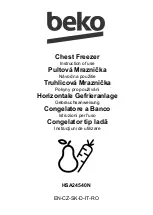
EN -10-
CHAPTER -3: USING YOUR FRIDGE FREEZER
Adapti-Lift Door Shelf
(In some models)
Six different height adjustments can be made to provide storage
areas that you need by Adapti-Lift.
To change the position of Adapti-Lift ;
Hold the bottom of the shelf and pull the buttons on the side of
the door shelf direction of arrow (Fig.1)
Position door shelf the height you need by moving up and down.
After you get the position that you want the door shelf, release
the buttons on the side of the door shelf (Fig.2) Before releasing
the door shelf, move up down and make sure the door shelf is
fixed
Note:
Before moving door shelf is loaded, you must hold the shelf by supporting the bottom. Otherwise, door shelf
could fall off the rails due to the weight. So damage may occur on the door shelf or rails.
Visual and text descriptions on the accessories section may vary according which model you have..
CHAPTER -4: FOOD STORAGE
Refrigerator Compartment
• To reduce humidity and avoid the consequent formation of frost, always store liquids in sealed containers in the
refrigerator. Frost tends to concentrate in the coldest parts of the evaporating liquid and, in time, your appliance
will require more frequent defrosting.
• Never place warm food in the refrigerator. Warm food should be allowed to cool at room temperature and should
be arranged to ensure adequate air circulation in the refrigerator compartment.
• Make sure no items are in direct contact with the rear wall of the appliance as frost will develop and packaging
will stick to it. Do not open the refrigerator door frequently.
• We recommend that meat and clean fish are loosely wrapped and stored on the glass shelf just above the
vegetable bin where the air is cooler, as this provides the best storage conditions.
• Store loose fruit and vegetable items in the crisper containers.
• Store loose fruit and vegetables in the crisper.
• Storing fruit and vegetables separately helps prevent ethylene-sensitive vegetables (green leaves, broccoli,
carrot, etc.) being affected by ethylene-releaser fruits (banana, peach, apricot, fig etc.).
• Do not put wet vegetables into the refrigerator.
• Storage time for all food products depends on the initial quality of the food and an uninterrupted refrigeration
cycle before refrigerator storage.
• To avoid cross-contamination do not store meat products with fruit and vegetables. Water leaking from meat
may contaminate other products in the refrigerator. You should package meat products and clean any leakages
on the shelves.
• Do not put food in front of the air flow passage.
• Consume packaged foods before the recommended expiry date.
• For normal working conditions, it will be sufficient to adjust the temperature setting of your refrigerator to +4 °C.
• The temperature of the fridge compartment should be in the range of 0-8 °C, fresh foods below 0 °C are iced
and rotted, bacterial load increases above 8 °C, and spoils.
• Do not put hot food in the refrigerator immediately, wait for the temperature to pass outside. Hot foods increase
the degree of your refrigerator and cause food poisoning and unnecessary spoiling of the food.
• Meat, fish, etc. should be store in the chiller compartment of the food, and the vegetable compartment is
preferred for vegetables. (if available)
• To prevent cross contamination, meat products and fruit vegetables are not stored together.
• Foods should be placed in the refrigerator in closed containers or covered to prevent moisture and odors.
NOTE
: Potatoes, onions and garlic should not be stored in the refrigerator.
Freezer Compartment
• The freezer is used for storing frozen food, freezing fresh food, and making ice cubes.
• To freeze fresh food, ensure that as much of the surface of the food as possible is in contact with the cooling
surface.
• Do not store fresh food next to frozen food as it can thaw the frozen food.
• Before freezing fresh food, divide it into portions that can be consumed in one sitting.
• Consume thawed frozen food within a short period of time after defrosting
• Never place warm food in the freezer compartment as it will thaw the frozen food.
• Always follow the manufacturer's instructions on food packaging when storing frozen food. If no information is
provided food, should not be stored for more than 3 months from the date of purchase.






































